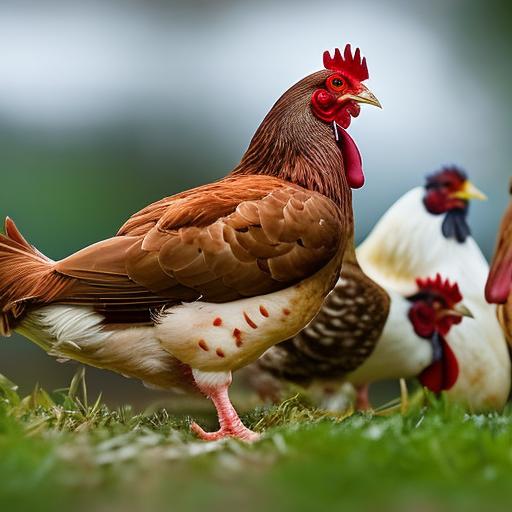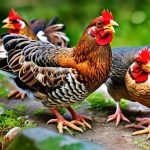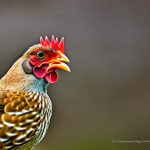Poultry mortality is a significant concern in the farming industry. Whether it’s backyard chicken keepers or large-scale commercial operations, understanding the factors that contribute to poultry mortality is crucial for maintaining healthy flocks and ensuring the success of the poultry business. Poultry mortality can have a significant impact on the financial viability of a farm, as well as the welfare of the birds.
There are various factors that can contribute to poultry mortality, including poor nutrition, infectious diseases, environmental factors, predators and pests, genetics and breeding, stress and overcrowding, and age and lifecycle. Each of these factors plays a role in the overall health and wellbeing of chickens, and understanding them is essential for preventing unnecessary deaths and promoting optimal flock health.
Key Takeaways
- Understanding poultry mortality is crucial for maintaining a healthy flock.
- Poor nutrition, infectious diseases, environmental factors, predators and pests, genetics and breeding, stress and overcrowding, and age all impact poultry health.
- Feed quality and quantity are important for maintaining chicken health.
- Environmental factors like temperature, humidity, and housing conditions can affect chickens’ health.
- Biosecurity measures and treatment/prevention strategies are important for keeping chickens healthy and safe.
Poor Nutrition: How Feed Quality and Quantity Affect Chickens’ Health
Poor nutrition is one of the leading causes of poultry mortality. Chickens require a balanced diet that provides them with the necessary nutrients to support their growth, immune function, and overall health. When chickens do not receive adequate nutrition, they become more susceptible to diseases and infections, have weakened immune systems, and may experience stunted growth or reproductive issues.
Farmers can ensure that their chickens receive adequate nutrition by providing them with high-quality feed that meets their specific nutritional requirements. This includes a balance of proteins, carbohydrates, fats, vitamins, and minerals. Additionally, farmers should monitor feed consumption to ensure that chickens are eating enough to meet their energy needs. Regularly assessing the body condition of chickens can also help identify any nutritional deficiencies or imbalances.
Infectious Diseases: Common Viruses, Bacteria, and Parasites that Affect Poultry
Infectious diseases are another significant factor contributing to poultry mortality. There are several common viruses, bacteria, and parasites that can affect poultry, including avian influenza, Newcastle disease, coccidiosis, and Marek’s disease. These diseases can have severe effects on chickens, leading to respiratory issues, organ failure, reduced egg production, and even death.
Preventing the spread of infectious diseases is crucial for maintaining healthy flocks. Vaccination is an essential tool in preventing the spread of diseases such as avian influenza and Newcastle disease. Additionally, implementing biosecurity measures, such as limiting access to the farm, practicing good hygiene, and regularly disinfecting equipment and facilities, can help prevent the introduction and spread of diseases.
Environmental Factors: How Temperature, Humidity, and Housing Conditions Impact Chickens
| Environmental Factor | Impact on Chickens |
|---|---|
| Temperature | High temperatures can cause heat stress, decreased egg production, and even death. Low temperatures can cause hypothermia and decreased egg production. |
| Humidity | High humidity can increase the risk of respiratory diseases and decrease egg production. Low humidity can cause dehydration and decreased egg production. |
| Housing Conditions | Poor housing conditions can lead to overcrowding, increased risk of disease, and decreased egg production. Proper housing conditions can promote good health and increase egg production. |
Environmental factors play a significant role in the health and mortality rates of chickens. Temperature and humidity levels can have a profound impact on chickens’ ability to regulate their body temperature. Extreme heat or cold can lead to heat stress or hypothermia, respectively, which can be fatal if not addressed promptly.
Proper housing conditions are essential for protecting chickens from environmental stressors. Providing adequate ventilation, insulation, and access to shade or shelter can help regulate temperature and humidity levels within the coop. Additionally, ensuring that chickens have enough space to move around comfortably and access to clean water at all times is crucial for their overall health and wellbeing.
Predators and Pests: Protecting Chickens from Natural Threats
Predators and pests pose a significant threat to the safety and wellbeing of chickens. Common predators include foxes, raccoons, snakes, and birds of prey, while pests such as mites, lice, and rodents can cause stress and transmit diseases to chickens.
Protecting chickens from predators and pests requires implementing effective strategies such as secure fencing, predator-proof housing, and regular pest control measures. Additionally, providing chickens with a safe outdoor area during the day that is protected from predators can allow them to engage in natural behaviors while minimizing the risk of predation.
Genetics and Breeding: How Selective Breeding Affects Poultry Health

Selective breeding plays a crucial role in shaping the health and mortality rates of poultry. Breeding for specific traits, such as increased egg production or faster growth, can inadvertently lead to negative health consequences. For example, chickens bred for rapid growth may be more prone to skeletal issues or heart problems.
Responsible breeding practices are essential for maintaining the overall health and wellbeing of chickens. Breeders should prioritize selecting breeding stock with good genetic health and diversity, as well as focusing on traits that promote longevity and disease resistance. Regular health screenings and genetic testing can help identify any potential health issues within a breeding program.
Stress and Overcrowding: The Negative Effects of Poor Management Practices
Stress and overcrowding can have detrimental effects on chickens’ health and mortality rates. Chickens that are subjected to chronic stress or overcrowded conditions are more susceptible to diseases, have weakened immune systems, and may exhibit aggressive or abnormal behaviors.
Responsible management practices are crucial for minimizing stress and overcrowding in poultry flocks. Providing adequate space per bird, ensuring proper ventilation, and implementing enrichment activities can help reduce stress levels. Additionally, avoiding sudden changes in flock composition or routine can help minimize stress and promote a more stable social environment.
Age and Lifecycle: Understanding the Natural Lifespan of Chickens
Understanding the natural lifespan of chickens is essential for farmers to provide appropriate care throughout their lives. Chickens typically have a lifespan of 5-10 years, depending on the breed and individual factors. As chickens age, they may become more susceptible to diseases, have reduced egg production, and experience a decline in overall health.
Farmers can ensure that their chickens live healthy and fulfilling lives by providing appropriate care at each stage of their lifecycle. This includes providing a balanced diet, regular veterinary care, and monitoring for any signs of illness or decline in health. Additionally, providing appropriate housing and environmental conditions can help support the aging process and promote a higher quality of life for older chickens.
Biosecurity Measures: Preventing the Spread of Disease and Infection
Biosecurity measures are crucial for preventing the spread of disease and infection within poultry flocks. Implementing effective biosecurity protocols can help minimize the risk of introducing diseases to the farm and prevent the spread of existing infections.
Some strategies for implementing effective biosecurity measures include limiting access to the farm, practicing good hygiene, regularly disinfecting equipment and facilities, and monitoring for any signs of illness or disease. Additionally, quarantining new birds before introducing them to the flock can help prevent the introduction of diseases.
Treatment and Prevention: Strategies for Keeping Chickens Healthy and Safe
Treating and preventing common health issues in chickens requires a multi-faceted approach. Regular veterinary care is essential for diagnosing and treating any illnesses or diseases that may arise. Additionally, implementing responsible management practices, such as providing adequate nutrition, maintaining proper housing conditions, and practicing good biosecurity measures, can help prevent many health issues from occurring in the first place.
Regular monitoring of flock health, including observing behavior, assessing body condition, and conducting routine health screenings, can help identify any potential issues early on. Prompt intervention and treatment can significantly improve the chances of a positive outcome for sick or injured birds.
In conclusion, understanding the various factors that contribute to poultry mortality is crucial for farmers who want to keep their chickens healthy and safe. By implementing responsible management practices, providing adequate nutrition and housing, and taking steps to prevent the spread of disease and infection, farmers can help ensure that their chickens live long and healthy lives. By prioritizing the health and wellbeing of their flocks, farmers can not only protect their investment but also promote sustainable and ethical farming practices.
If you’re wondering why your chickens keep dying, it’s important to evaluate their living conditions. One crucial factor to consider is the size of their coop. A coop that is too small can lead to overcrowding and stress among the chickens, which can make them more susceptible to diseases and health issues. To learn more about how big a coop needs to be for a chicken, check out this informative article on poultrywizard.com. Understanding the proper coop size can help ensure the well-being and longevity of your feathered friends.
FAQs
What are some common reasons why chickens die?
Chickens can die due to a variety of reasons such as disease, parasites, predators, poor nutrition, dehydration, extreme weather conditions, and stress.
How can I prevent my chickens from dying?
To prevent chickens from dying, it is important to provide them with a clean and safe living environment, a balanced diet, access to clean water, protection from predators, and regular health check-ups.
What are some signs that my chickens may be sick?
Some signs that your chickens may be sick include lethargy, loss of appetite, weight loss, diarrhea, abnormal breathing, discolored or swollen eyes, and unusual behavior.
What should I do if I suspect my chickens are sick?
If you suspect your chickens are sick, it is important to isolate them from the rest of the flock and seek veterinary care immediately. It is also important to practice good biosecurity measures to prevent the spread of disease.
How can I protect my chickens from predators?
To protect chickens from predators, it is important to provide a secure coop and run, use fencing or netting to keep predators out, and supervise chickens when they are free-ranging. It is also important to remove any potential hiding places for predators near the coop.
Meet Walter, the feathered-friend fanatic of Florida! Nestled in the sunshine state, Walter struts through life with his feathered companions, clucking his way to happiness. With a coop that’s fancier than a five-star hotel, he’s the Don Juan of the chicken world. When he’s not teaching his hens to do the cha-cha, you’ll find him in a heated debate with his prized rooster, Sir Clucks-a-Lot. Walter’s poultry passion is no yolk; he’s the sunny-side-up guy you never knew you needed in your flock of friends!







